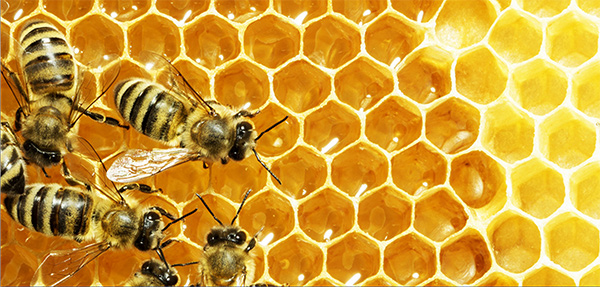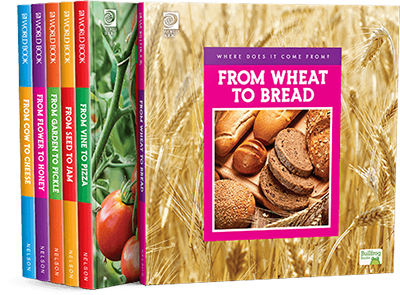From Bees to Honey

From Bees to Honey
Eat up! Discover how honey gets from farms to gardens to our tables.
Bees live in almost every part of the world except near the North and South poles. Bees are one of the most useful of all insects. They produce honey, which people use as food; and beeswax, which is used in such products as adhesives, candles, and cosmetics. There are about 20,000 species of bees. Only the kinds known as honey bees make honey and wax in large enough amounts to be used by people.
Flowers provide food for bees. The bees collect tiny grains of pollen and a sweet liquid called nectar from the blossoms they visit. They make honey from the nectar, and use both honey and pollen as food. During their food-gathering flights, bees spread pollen from one flower to another, thus pollinating the plants they visit. This enables the plants to reproduce. Numerous wild plants and such important food crops as fruits and vegetables depend on bees for fertilisation.
Bees probably developed from wasplike ancestors that first got their food by eating other insects. These creatures gradually switched to flowers as their food source. In time, bees became completely dependent on flowers for food. The flowers, in turn, benefited from the bees. Scientists believe that over the years, bees helped create the wide variety of flowers in the world today by spreading pollen among various plants.
The Honey Bee Colony
A typical honey bee colony is made up of one queen, tens of thousands of workers, and a few hundred drones. The queen is the female honey bee that lays eggs. The workers are the unmated female offspring of the queen. The drones are the male offspring.
The hive is a storage space, such as a hollow tree or a box, which contains a honeycomb. The honeycomb is a mass of six-sided compartments called cells. Worker bees build the honeycomb of wax produced by their bodies. They also collect a sticky substance called propolis, or bee glue, from certain kinds of trees. They use it to repair cracks in the hive.
The honeycomb is used to raise young bees and to store food. The queen bee lays one egg in each cell in part of the honeycomb. In general, the cells containing the eggs and developing bees are in the centre of the hive. This area is called the brood nest. The bees store pollen and honey in cells above and around the brood nest. The same cells may be used for different purposes. During spring and summer, many cells are used to raise young bees. In autumn, brood production stops, and more cells are available for storing honey through the winter.
Watch a video showing how a bee makes honey.
Making Honey
Flowers often have special glands, called nectaries, that produce nectar. Worker honey bees suck up nectar from the flowers with their long tongues and store it in their honey stomachs. In the stomach, a process called inversion breaks down the sugar in the nectar into two simple sugars, fructose and glucose. When the worker bee returns to the hive, it regurgitates (spits up) the nectar back through its mouth. It either gives the nectar to other bees or puts it in an empty cell in the hive. As the water in the nectar evaporates, the nectar changes into honey.
Workers then put wax caps on the honey-filled cells. Beekeepers collect honey from the combs. But they leave enough in the hive to feed the bees.
History of Honey
Honey was an important sweet in ancient times.
The people of the Stone Age, thousands of years ago, ate honey that they stole from the hives of wild bees. Some of these people learned to make crude hives for the bees, so the honey would be near their homes. They probably made these first beehives out of hollow logs, a pot placed on its side, or a basket turned upside down. Later, farmers in Europe built straw skeps that looked like upside-down baskets.
Stingless Bees
Stingless bees have small stings but do not use them as weapons. They prefer to bite with their jaws. Stingless bees live only in tropical and near-tropical areas.
Where Does It Come From?
World Book has released a 6 volume series using infographics to illustrate the cycle of different foods with real photos and descriptions.
In From Flower to Honey, early readers learn how honey is made, from bees collecting flower nectar to beekeepers collecting and jarring it.
Other titles in the series:
From Cow to Cheese
From Garden to Pickle
From Seed to Jam
From Vine to Pizza
From Wheat to Bread

Interested in learning more about Where Does It Come From? click here.
If you’re not a subscriber to World Book Online, try it for free.
RECENT POSTS & TIPS
- Anzac Day
- International Women's Day
- Australian women's rights campaigner Vida Goldstein
- SALE! 2023 WORLD BOOK ENCYCLOPEDIA
- Australian Aboriginal Languages
- Beware the Bunyip
- Shark
- From Bees to Honey
- World Book Wizard has arrived!
- World Book Online: Winners and Finalists at the 2021 EdTech Cool Tech Awards!
- Computer Science
- Help Build Reluctant Readers’ Confidence



